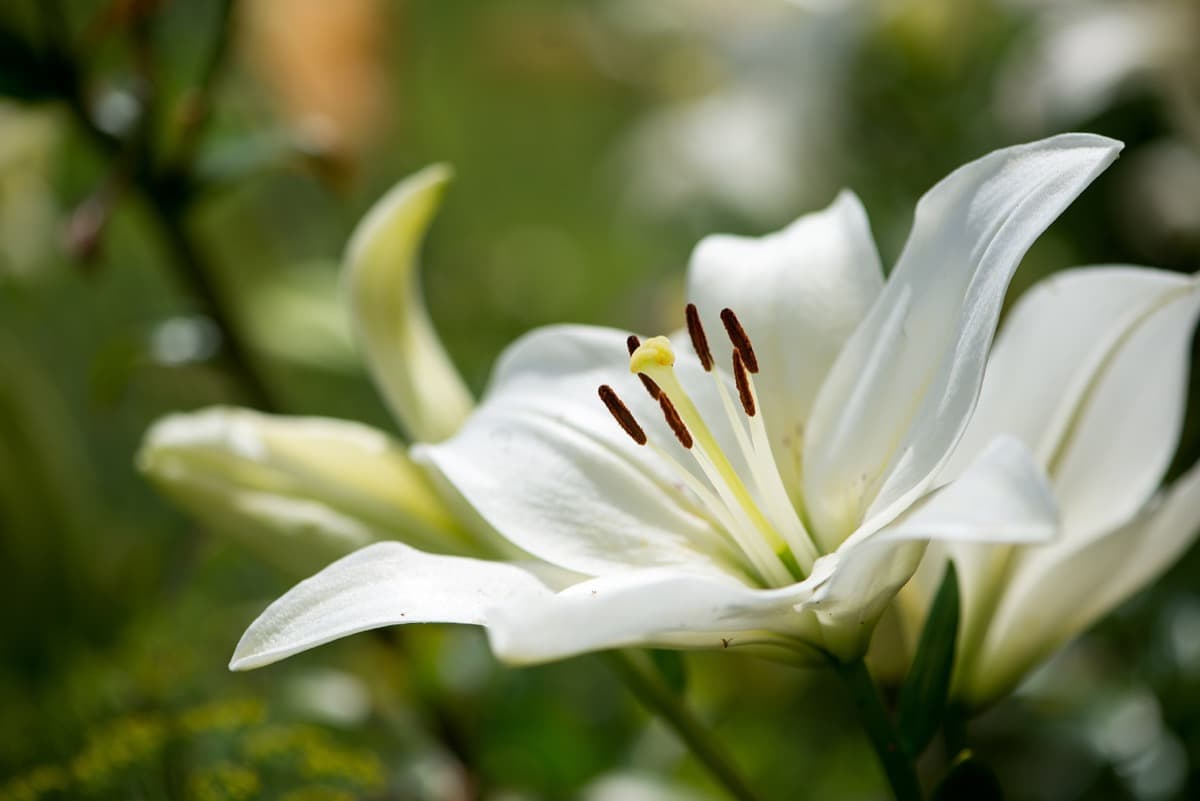Welcome to our blog post on Common Lily Plant Diseases! Lilys are extraordinary garden additions with their attractive blooms and multiple varieties. Still, like any plant, they are prone to a range of common diseases that can hinder their beauty and health. This blog post aims to discuss 10 of the most common lily diseases, including their symptoms, treatments, prevention, and management. So, buckle up to explore the lily plants’ ten most common diseases.

Important Points for Beginners to Identify and Manage Diseases in Lily Plants
- Identifying the Disease: The first step is identifying the disease infesting your lily plant so that you can approach it with the most effective control method.
- Regular Monitoring: Monitor your lily plants regularly for signs of diseases. This will help you to identify an infestation early when it is easier to control.
- Sanitation: Remove the infected plant debris and burn them.
- Natural Control: Several natural control methods can help to manage diseases. These include plant extracts, essential oils, composting, and organic fungicides.
- Chemical Control: If natural controls are ineffective, use fungicides as a last resort, and follow the label instructions and dosage carefully.
Common Lily Plant Damaging Diseases
Anthracnose Disease in Lily Plant
Disease Symptoms by Colletotrichum gloeosporioides: The characteristic symptom of the disease is the brown or black lesions on leaves. Infected plants show leaf wilting, chlorosis, dieback, sunken lesions on the stem and bulb, and flower blight.
Survival and Spread: Colletotrichum gloeosporioides prefer warm and humid weather of 20-30°C for spore germination. Prolonged periods of leaf wetness, overcrowding, injuries, and poor airflow contribute to the disease.
Treatment, Maintenance, and Control Measures: Spray chlorothalonil, thiophanate-methyl, mancozeb, azoxystrobin, and propiconazole. Avoid overwatering, practice plant spacing, mulching, and sanitation.
Rust Disease in Lily Plant
Disease Symptoms by Puccinia spp: The primary symptom is the appearance of small, raised, orange, reddish-brown, or rust-colored pustules. They form leaf spots surrounded by a yellow halo. Infected plants show spore production, wilting, chlorosis, stunted growth, and premature leaf drop.
Survival and Spread: Puccinia spp prefers warm and humid conditions of 15-30°C for spore production. Wet and splashy environments, overcrowding, poor airflow, overwatering, plant debris, and airborne spore dispersal can contribute to the disease.
Treatment, Maintenance, and Control Measures: Spray copper hydroxide, copper oxychloride, copper sulfate, propiconazole, tebuconazole, myclobutanil, azoxystrobin, and mancozeb. Practice crop rotation, spacing, sanitation, and fertilization.
Foot Rot Disease in Lily Plant
Disease Symptoms by Phytophthora cryptogea: The disease primarily affects the root system of lily plants. Infected plants show leaf wilting, chlorosis, root discoloration, decay, water-soaked symptoms, and crown rot.
Survival and Spread: Phytophthora cryptogea prefers a warm and humid climate of 20-25°C, >80% humidity, and slightly acidic to neutral soil of pH 5.5 to 7. Excess moisture, poor drainage, plant debris, dense canopy, and poor airflow contribute to the disease.
Treatment, Maintenance, and Control Measures: Spray metalaxyl, mancozeb, fosetyl-aluminum, dimethomorph, and phosphorous acid. Maintain proper drainage, perform soil fumigation, and follow crop rotation and sanitation.
In case you missed it: 10 Common Lily Plant Damaging Pests: Symptoms, Treatment, Prevention, and Management

Powdery Mildew Disease in Lily Plant
Disease Symptoms by Erysiphe cichoracearum: The characteristic symptom of the disease is the white or grayish powdery fungal patches on the leaves, stems, and buds. Infected plants show a powdery or dusty appearance, leaf distortion, stunted growth, chlorosis, curling, premature dropping, and reduced flowering.
Survival and Spread: Erysiphe cichoracearum prefers moderate temperatures, high humidity of 15-25°C, and >70% humidity for spore germination. Prolonged leaf wetness, poor airflow, shade, plant stress, and overcrowding create an ideal environment.
Treatment, Maintenance, and Control Measures: Spray wettable sulfur, myclobutanil, tebuconazole, propiconazole, azoxystrobin, chlorothalonil, and mancozeb. Avoid overwatering, practice spacing and sanitation.
Downy Mildew Disease in Lily Plant
Disease Symptoms by Peronospora spp: One of the earliest symptoms is the wilting and chlorosis of leaves. The affected plants show leaf chlorosis, downy growth, wilting, distorted growth, and premature leaf drop.
Survival and Spread: Peronospora spp prefers moderate temperatures and humid weather of 15-25°C and >85% moisture for reproduction and survival. Waterlogging, poor airflow, debris, and plant stresses are ideal for the pathogen.
Treatment, Maintenance, and Control Measures: Spray copper hydroxide, copper oxychloride, metalaxyl, mefenoxam, dimethomorph, mancozeb, and chlorothalonil. Apply resistance-inducing agents like Acibenzolar-S-methyl or Potassium phosphite.
Smut Disease in Lily Plant
Disease Symptoms by Ustilago lilii: The characteristic symptom is the formation of raised galls or swellings on stems, leaves, and flowers. Infested plants show black powdery spore mass, leaf chlorosis, distortion, defoliation, and reduced flower production.
Survival and Spread: Ustilago lilii prefers a warm and humid climate of 20-30°C for spore germination. Prolonged leaf wetness, overcrowding, poor air circulation, plant stress, overhead irrigation, and plant debris contribute to disease spread.
Treatment, Maintenance, and Control Measures: Spray mancozeb, chlorothalonil, copper sulfate, copper oxychloride, azoxystrobin, fludioxonil, propiconazole, tebuconazole, thiram, and captan. Avoid overhead watering and inspect plants regularly.
White Mold Disease in Lily Plant
Disease Symptoms by Sclerotinia sclerotiorum: The characteristic symptom is the development of white, fluffy mycelium and water-soaked lesions on stems and leaves. Infected plants show decay, leaf chlorosis, wilting, dieback, and sclerotia formation.
Survival and Spread: Sclerotinia sclerotiorum prefers cool and moist weather of 15-25°C. Prolonged leaf wetness, overhead irrigation, high plant density, poor air circulation, injuries, and plant debris create a conducive environment for the disease.
Treatment, Maintenance, and Control Measures: Spray boscalid, iprodione, thiophanate-methyl, fluazinam, azoxystrobin, chlorothalonil, and mancozeb. Practice plant spacing, crop rotation, and maintain drainage.
Botrytis Blight or Grey Mold Disease in Lily Plant
Disease Symptoms by Botrytis cinerea: The characteristic symptom is the grayish-brown lesions on leaves, stems, flowers, and buds. Infected plants show flower blight, fuzzy grayish-white mold, and collapsed buds and blossoms.
Survival and Spread: Botrytis cinerea prefers warm weather of 15-25°C and >85% humidity for spore germination. Prolonged Leaf Wetness, dense canopy, older plant parts, injuries, overcrowding, and poor air circulation contribute to the disease.
Treatment, Maintenance, and Control Measures: Spray copper hydroxide, copper sulfate, thiophanate-methyl, triadimefon, triadimenol, fenarimol, iprodione, vinclozolin, mancozeb, zineb, azoxystrobin, tebuconazole, and propiconazole. Use biocontrol agents like Bacillus subtilis and Trichoderma spp.
Fusarium Wilt Disease in Lily Plant
Disease Symptoms by Fusarium oxysporum f. sp. lilii: The primary symptom is the sudden and progressive wilting of the entire plant. Infected plants show leaf wilting, chlorosis, vascular discoloration, stunted growth, and death.
Survival and Spread: Fusarium oxysporum prefers warm, moist, acidic soils of 25-30°C, pH 5.5 to 6.5 for survival. Waterlogging, plant stress, debris, poor air circulation, and dense canopy create an ideal environment for the disease’s spread.
Treatment, Maintenance, and Control Measures: Spray thiophanate-methyl, metalaxyl, propiconazole, tebuconazole, and azoxystrobin. Treat the seeds with Trichoderma and Bacillus spp. Practice soil solarization and apply soil amendments, such as organic matter or compost.
In case you missed it: Common Cotton Damaging Pests and Control: Symptoms, Identification, Pest Cycle, Treatment, and Management

Root Rot Disease in Lily Plant
Disease Symptoms by Rhizoctonia solani: Root rot disease primarily attacks the roots, causing them to become discolored, darkened, and decayed. Infected plants show rotting bulbs, leaf chlorosis, wilting, and stunted growth.
Survival and Spread: Rhizoctonia solani prefers warm and moist soil of 20-30°C for reproduction and survival. Excessive soil moisture, high plant density, poor drainage, plant stress, injuries, and debris provide a conducive environment.
Treatment, Maintenance, and Control Measures: Spray metalaxyl, fludioxonil, mancozeb, zineb, chlorothalonil, carbendazim, thiophanate-methyl, iprodione, azoxystrobin, pyraclostrobin, propiconazole, and tebuconazole. Follow proper watering, adequate plant spacing, good air circulation, and sanitation.
Conclusion
Common lily plant diseases include anthracnose, rust, foot rot, powdery mildew, downy mildew, smut, white mold, botrytis blight, fusarium wilt, and root rot. By identifying the disease, inspecting plants regularly, and using natural control methods, you can help to keep your lily plants healthy and beautiful.
- Beneficial Insects in Pest Management
- Natural Solutions for Pest Control in Flower Gardens
- Types of Fungicides Used in Agriculture
- Common Issues in the Fruit Development Stage of Pomegranate Farming
- Fruit Development Issues in Papaya: Easy Solutions and Treatment
- Soil-Borne Diseases and How to Protect Your Plants
- Practices to Prevent Disease Spread in the Garden
- From Wilted to Thriving: How to Treat Root Rot Naturally in Houseplants
- Natural Remedies to Cure Brown Spots on Fig Tree Leaves